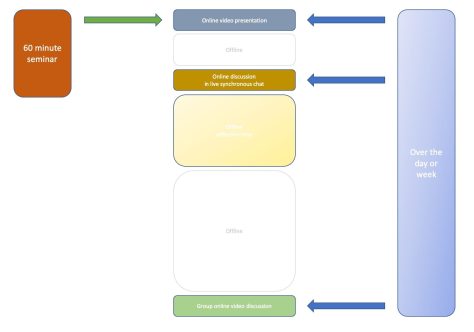
I have been working on a series of blog posts about translating existing teaching practices into online models of delivery. In a previous post I looked at translating the lecture, in this one I am looking at the seminar, or group tutorial.
As well as lectures many university courses have group discussions or seminar to talk about topics or subjects. These often consist of a one hour session led or steered by an academic member of staff.
One of the things I have noticed as the education sector moved rapidly to remote delivery was the different models that people used. However what we did see was many people were translating their usual practice to an online version.
Dave White in a recent blog post about his experiences at UAL called it practice mirroring.
As part of my work in looking at the challenges in delivering teaching remotely during this crisis period I have been reflecting on how teaching staff can translate their existing practice into new models of delivery that could result in better learning, but also have less of detrimental impact on staff an students.

Merely translating that one hour seminar into a one hour Teams or Zoom discussion probably works fine for many in isolation. However it’s not just an hour, students may also be involved in other online seminars, Zoom lectures, live video streams and more online content.
This can be exhausting for those taking part, but also we need to remember that in this time there are huge number of other negative factors impacting on people’s wellbeing, energy and motivation. People may not be able to participate in synchronous sessions, they may have childcare or other dependents they need to look after, they may be other household challenges.
So how do you, and how could you translate the one hour seminar into an effective learning experience that happens online. The key aspect is to identify the learning outcomes of that seminar or tutorial and ensure that they are achievable in the translated session.
So at a simple level, you could translate your 60minute seminar into a 60 minute online video chat.
Apart from the challenges of online video chat and synchronous discussions already mentioned, running an online video chat, is a different experience to doing a face to face conversation. It can be harder to read the visual cues that we take for granted when listening and speaking. It’s challenging to avoid a stilted conversation, as participants try and engage when there are latency issues. Multiple people all trying to speak at once.
So though experienced in a face to face seminar, it can be useful to structure and plan the video chat, so the students have a clear idea about what is expected of them and what they will need to contribute to the discussion.
If you have a simultaneous textual chat during the online video chat then it can help to have another person to review that in addition to the person running the seminar. Some students may prefer to post their thoughts and questions to a text chat than turn on their video and use the microphone. They may also be in an environment where that isn’t possible.
You could even lose the video aspect.
So another possible translation, you could take your 60minute seminar into a 60 minute synchronous live text chat.
So avoiding the video and using the textual chat function of your learning platform or use a tools such as Teams to do this. Again it can be useful to structure and plan the textual chat, so the students have a clear idea about what is expected of them and what they will need to write and reply, when contributing to the discussion.
You could add a recorded (or live) video introduction to the seminar and then go to the chat and discussion side of the seminar.
As with the lecture translation, you might want to avoid trying to compress everything into an hour and spread the components of the online seminar across the day or even a week.
Use the recorded (or live) video introduction to the seminar, then move to online discussion in live synchronous chat a bit later. Follow this with some offline reflection time or activities (away from the screen) before all coming back to an online video discussion at the end of the day or later in the week.
The teacher interaction (mapped here as blue arrows) shows their involvement.
Another option would be to move all the discussion to asynchronous online discussion
in chat.
There is an introductory video, but all discussion is then undertaken through the asynchronous online chat, allowing people a chance to reflect and think about the topic and dip in and out as they want to and are able to.
The teacher interaction (mapped here as blue arrows) becomes more flexible and previous experience will potentially see the students helping each other. The synchronous activity is reduced to a short session. Students can decide when to participate and adapt it to their own personal circumstances.

In terms of contact hours, or timetabling you can see how the final model would be challenging.
Simply translating what we do in our physical buildings into a online remote version, is relatively simple, however it may not be effective. Thinking about what you want that learning experience to achieve and what you want the students to learn, means you can do different things. Of course knowing how to do those different things, is another challenge.






4 thoughts on “Lost in translation: the seminar”